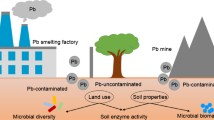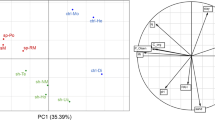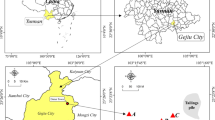Abstract
Intensive use of atrazine and extensive dispersal of lead (Pb) have occurred in farmland with chemical agriculture development. However, the toxicological effect of their presence on soil microorganism remains unknown. The objective of this study was to investigate the impacts of atrazine or Pb on the soil microbiota, soil net nitrogen mineralization, and atrazine residues over a 28-day microcosm incubation. The Shannon-Wiener diversity index, typical microbe species, and a Neighbor-joining tree of typical species from sequencing denaturing gradient gel electrophoresis (DGGE) bands were determined across periodical sampling times. The results showed that the existence of atrazine or Pb (especially high concentration) in soils reduced microbial diversity (the lowest H value is 2.23) compared to the control (H = 2.59) after a 28-day incubation. The species richness reduced little (from 17~19 species to 16~17 species) over the research time. But soil microbial community was significantly affected by the incubation time after the exposure to atrazine or Pb. The combination of atrazine and Pb had a significant inhibition effect on soil net nitrogen nitrification. Atrazine and Pb significantly stimulated soil cumulative net nitrogen mineralization and nitrification. Pb (300 and 600 mg kg−1) accelerated the level of atrazine dissipation. The exposure might stimulate the significant growth of the autochthonous soil degraders which may use atrazine as C source and accelerate the dissipation of atrazine in soils.




Similar content being viewed by others
References
Altesor A, Oesterheld M, Leoni E, Lezama F, Rodríguez C (2005) Effect of grazing on community structure and productivity of a Uruguayan grassland. Plant Ecol 179:83–91
Augustine DJ, McNaughton SJ (2006) Interactive effects of ungulate herbivores, soil fertility, and variable rainfall on ecosystem processes in a semi-arid savanna. Ecosystems 9:1242–1256
Bai Z, Xu H, He H, Zheng L, Zhang X (2013) Alterations of microbial populations and composition in the rhizosphere and bulk soil as affected by residual acetochlor. Environ Sci Pollut Res 20:369–379
Bao S (2005) Soil agricultural chemical analysis. China Agriculture Press, Beijing, pp 47–57
Bloem J, Breure AM (2003) Microbial indicators. In: Markert BA, Breure AM, Zechmeister HG (eds) Bioindicators and biomonitors. Elsevier, Oxford, pp 259–282
Briceño G, Jorquera MA, Demanet R, Mora ML, Durán NG, Palma N (2010) Effect of cow slurry amendment on atrazine dissipation and bacterial community structure in an agricultural Andisol. Sci Total Environ 408:2833–2839
Burges A, Epelde L, Garbisu C (2015) Impact of repeated single-metal and multi-metal pollution events on soil quality. Chemosphere 120:8–15
Chapin FS III, Matson PA, Mooney HA (2002) Principles of terrestrial ecosystem ecology. Springer, New York
Chen Y, Borken W, Stange CF, Matzner E (2011) Effects of decreasing water potential on gross ammonification and nitrification in an acid coniferous forest soil. Soil Biol Biochem 43:333–338
Chen Q, Wang H, Yang B, He F (2014) The combined effects of atrazine and lead (Pb): relative microbial activities and herbicide dissipation. Ecotox Environ Safe 102:93–99
Cheng Y, Wang J, Mary B, Zhang J, Cai Z, Scott X, Chang S (2013) Soil pH has contrasting effects on gross and net nitrogen mineralizations in adjacent forest and grassland soils in central Alberta, Canada. Soil Biol Biochem 57:848–857
Chu H, Fujii T, Morimoto S, Lin X, Yagi K (2008) Population size and specific nitrification potential of soil ammonia-oxidizing bacteria under long-term fertilizer management. Soil Biol Biochem 40:1960–1963
Cycoń M, Piotrowska-Seget Z, Kozdroj J (2010) Linuron effects on microbiological characteristics of sandy soils as determined in a pot study. Ann Microbiol 60:439–449
Cycoń M, Anna M, Piotrowska-Segetb Z (2013a) Structural and functional diversity of bacterial community in soil treated with the herbicide napropamide estimated by the DGGE, CLPP and r/K-strategy approaches. Appl Soil Ecol 72:242–250
Cycoń M, Wojcik M, Borymski S, Piotrowska-Seget Z (2013b) Short-term effects of the herbicide napropamide on the activity and structure of the soil microbial community assessed by the multi-approach analysis. Appl Soil Ecol 66:8–18
Dewey KA, Gaw SK, Northcott GL, Lauren DR, Hackenburg S (2012) The effects of copper on microbial activity and the degradation of atrazine and indoxacarb in a New Zealand soil. Soil Biol Biochem 52:64–74
El-Ghamry AM, Xu J, Huang C, Gan J (2002) Microbial response to bensulfuron-methyl treatment in soil. J Agric Food Chem 50:136–139
Gil SV, Meriles J, Conforto C, Basanta M, Radl V, Hagn A, Schloter M, March GJ (2011) Response of soil microbial communities to different management practices in surface soils of a soybean agroecosystem in Argentina. Eur J Soil Biol 47:55–60
Hicks RJ, Stotzky G, van Voris P (1990) Review and evaluation of the effects of xenobiotics chemicals on microorganisms in soil. In: Neidelman SL, Laskin AI (eds) Advances in applied microbiology. Academic, San Diego, pp 195–253
Hsiao YL, Ho WH, Yen JH (2013) Vertical distribution in soil column and dissipation in soil of benzoylurea insecticides diflubenzuron, flufenoxuron and novaluron and effect on the bacterial community. Chemosphere 90:380–386
Kadian N, Gupta A, Satya S, Kumari-Mehta R, Malik A (2008) Biodegradation of herbicide (atrazine) in contaminated soil using various bioprocessed materials. Bioresour Technol 99:4642–4647
Karpouzas DG, Kandeler E, Bru D, Friedel I, Auerb Y, Kramer S, Vasileiadis S, Petric I, Udikovic-Kolic N, Djuric S, Martin-Laurent F (2014) A tiered assessment approach based on standardized methods to estimate the impact of nicosulfuron on the abundance and function of the soil microbial community. Soil Biol Biochem 75:282–291
Konneke M, Bernhard AE, Dela-Torre JR, Walker CB, Waterbury JB, Stahl DA (2005) Isolation of an autotrophic ammonia-oxidizing marine archaeon. Nature 437:43–546
Lagomarsino A, Moscatelli MC, Di Tizio A, Mancinelli R, Grego S, Marinari S (2009) Soil biochemical indicators as a tool to assess the short-term impact of agricultural management on changes in organic C in a Mediterranean environment. Ecol Indic 9:518–527
Li K, Cheng J, Wang X, Zhou Y, Liu W (2008a) Degradation of herbicides Atrazine and Bentazone applied alone and in combination in soils. Pedosphere 18(2):265–272
Li X, Zhang H, Wu M, Su Z, Zhang C (2008b) Impact of acetochlor on ammonia-oxidizing bacteria in microcosm soils. J Environ Sci 20:1126–1131
Liao M, Chen C, Zeng L, Huang C (2007) Influence of lead acetate on soil microbial biomass and community structure in two different soils with the growth of Chinese cabbage (Brassica chinensis). Chemosphere 66:1197–1205
Littlefield-Wyer JG, Brooks P, Katouli M (2008) Application of biochemical fingerprinting and fatty acid methyl ester profiling to assess the effect of the pesticide Atradex on aquatic microbial communities. Environ Pollut 153:393–400
Lu M, Xu K, Chen J (2013) Effect of pyrene and cadmium on microbial activity and community structure in soil. Chemosphere 91:491–497
Lupwayi NE, Lafond GP, Ziadi N, Grant CA (2012) Soil microbial response to nitrogen fertilizer and tillage in barley and corn. Soil Till Res 118:139–146
Majer BJ, Tscherko D, Paschke A (2002) Effects of heavy metal contamination of soils on micronucleus induction in Tradescantia and on microbial enzyme activities: a comparative investigation. Mutat Res 515:111–124
Monard C, Martin-Laurent F, Vecchiato C, Francez AJ, Vandenkoornhuyse P, Binet F (2008) Combined effect of bioaugmentation and bioturbation on atrazine degradation in soil. Soil Biol Biochem 40:2253–2259
Morgan MC, Boyette M, Goforth C, Sperry KV, Greene SR (2009) Comparison of the Biolog OmniLog identification system and 16S ribosomal RNA gene sequencing for accuracy in identification of atypical bacteria of clinical origin. J MicrobiolMeth 79:336–343
Muhammad A, Xu J, Li Z, Wang H, Yao H (2005) Effects of lead and cadmium nitrate on biomass and substrate utilization pattern of soil microbial communities. Chemosphere 60:508–514
Prieto LH, Bertiller MB, Carrera AL, Olivera NL (2011) Soil enzyme and microbial activities in a grazing ecosystem of Patagonian Monte, Argentina. Geoderma 162:281–287
Renella G, Mench M, van der Lelie D, Pietramellara G, Ascher J, Ceccherini MT, Landi L, Nannipieri P (2004) Hydrolase activity, microbial biomass and community structure in long-term Pb-contaminated soils. Soil Biol Biochem 36:443–451
Rodrigues DF, Jaisi DP, Elimelech M (2013) Toxicity of functionalized single-walled carbon nanotubes on soil microbial communities: implications for nutrient cycling in soil. Environ Sci Technol 47:625–633
Rousidou C, Papadopoulou ES, Kortsinidou M, Giannakou IO, Singh BK, Menkissoglu-Spiroudi U, Karpouzas DG (2013) Bio-pesticides: harmful or harmless to ammonia oxidizing microorganisms? The case of a Paecilomyces lilacinus-based nematicide. Soil Biol Biochem 67:98–105
Seghers D, Verthé K, Reheul D, Bulcke R, Siciliano SD, Verstraete W, Top EM (2003) Effect of long-term herbicide applications on the bacterial community structure and function in an agricultural soil. FEMS Microbiol Ecol 46:139–146
Shan Y, Chen D, Guan X, Zheng S, Chen H, Wang M, Bai Y (2011) Seasonally dependent impacts of grazing on soil nitrogen mineralization and linkages to ecosystem functioning in Inner Mongolia grassland. Soil Biol Biochem 43:1943–1954
Shrestha B, Acosta-Martinez V, Cox SB, Green MJ, Li SB, Canas-Carrella JE (2013) An evaluation of the impact of multiwalled carbon nanotubes on soil microbial community structure and functioning. J Hazard Mater 261:188–197
Singer FJ, Schoenecker KA (2003) Do ungulates accelerate or decelerate nitrogen cycling? Forest Eco Manag 181:189–204
Singh AK, Cameotra SS (2014) Influence of microbial and synthetic surfactant on the biodegradation of atrazine. Environ Sci Pollut Res 21:2088–2097
Singh BK, Millard P, Whiteley AS, Murrell JC (2004) Unravelling rhizosphere—microbial interactions: opportunities and limitations. Trends Microbiol 12(8):386–393
Suhadolc M, Schroll R, Gattinger A, Schloter M, Munch JC, Lestan D (2004) Effects of modified Pb-, Zn-, and Cd- availability on the microbial communities and on the degradation of isoproturon in a heavy metal contaminated soil. Soil Biol Biochem 36:1943–1954
Sun Y, Zhou Q, Diao C (2008) Effects of cadmium and arsenic on growth and metal accumulation of Cd-hyperaccumulator Solanum nigrum L. Bioresour Technol 99:1103–1110
Tan H, Xu M, Li X, Zhang H, Zhang C (2013) Effects of chlorimuron-ethyl application with or without urea fertilization on soil ammonia-oxidizing bacteria and archaea. J Hazard Mater 260:368–374
Topp E (2001) A comparison of three atrazine-degrading bacteria for soil bioremediation. Biol Fert Soil 33:529–534
Tortella GR, Mella-Herrera RA, Sousa DZ, Rubilara O, Acuna JJ, Briceno G, Diez MC (2013a) Atrazine dissipation and its impact on the microbial communities and community level physiological profiles in a microcosm simulating the biomixture of on-farm biopurification system. J Hazard Mater 260:459–467
Tortella GR, Mella-Herrera RA, Sousa DZ, Rubilara O, Brice G, Parra L, Diez MC (2013b) Carbendazim dissipation in the biomixture of on-farm biopurification systems and its effect on microbial communities. Chemosphere 93:1084–1093
Verdenelli RA, Lamarque AL, Meriles JM (2012) Short-term effects of combined iprodione and vermicompost applications on soil microbial community structure. Sci Total Environ 414:210–219
Vurtice C, Albright III, Ian JM, Jennifer AA, Joel RC (2013) Fate of atrazine in switchgrass–soil column system. Chemosphere 90:1847–1853
Wu X, Xu J, Dong F, Liu X, Zheng Y (2014) Responses of soil microbial community to different concentration of fomesafen. J Hazard Mater 273:155–164
Zeng L, Liao M, Chen C, Huang C (2007) Effects of lead contamination on soil enzymatic activities, microbial biomass, and rice physiological indices in soil-lead-rice (Oryza sativa L.) system. Ecotox Environ Safe 67:67–74
Zhou J, Sun X, Jiao J, Liu M, Hu F, Li H (2013) Dynamic changes of bacterial community under the influence of bacterial-feeding nematodes grazing in prometryne contaminated soil. Appl Soil Ecol 64:70–76
Acknowledgments
The study was supported by National Natural Science Foundation of China (41101530 and 31270586), International Cooperative Project of Shandong Province (2012GHZ21702), State Key Laboratory of Forest and Soil Ecology (Grant No. LFSE2014-07), and Shandong Province Higher Educational Science and Technology Program (J11LB17). The authors sincerely thank the editor and anonymous reviewers for their thorough revision and invaluable comments which have helped to significantly improve the manuscript.
Author information
Authors and Affiliations
Corresponding authors
Additional information
Responsible editor: Robert Duran
Rights and permissions
About this article
Cite this article
Chen, Q., Yang, B., Wang, H. et al. Soil microbial community toxic response to atrazine and its residues under atrazine and lead contamination. Environ Sci Pollut Res 22, 996–1007 (2015). https://doi.org/10.1007/s11356-014-3369-7
Received:
Accepted:
Published:
Issue Date:
DOI: https://doi.org/10.1007/s11356-014-3369-7




